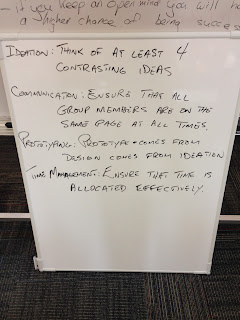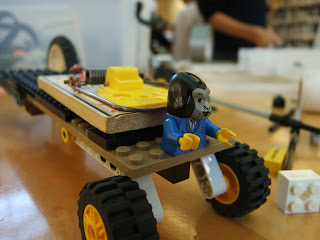 |
| Improvement time! |
Before I get to catching you up on our journey over the last few weeks, I should offer a partial explanation for the lack of posts on this blog over that time. As most who read this blog will know, all assessments have been done in the form of student blog posts this term. We have had no tests, essays or other more traditional forms of grading. The reason for this is that the curriculum for the Fusion course (remember that Fusion is a design course within the Fusion program that includes other courses such as Math and Science) is very fluid. There is no Ministry prescribed list of skills, concepts or facts that students must know. The students, especially in the first year of the program, come into the course at a wide variety of skill and conceptual levels in a myriad of areas. It is more effective to have students report and reflect on their learning at various points along the way rather than testing them at the end of a unit. For the work that we have done so far, these reflections tell me much more about what a student has actually learned than any multiple choice test ever would and is more responsive to the immediate learning that is going on than essay questions as part of a unit test. The down side to this approach to assessing the boys learning is that it takes more time on an ongoing basis to have these discussions via the blogs. I comment on most of the blog posts and ask questions that try to get deeper thinking when I can and to clarify understanding (mine and the boys'). I think that the time is well worth it, but it means that this blog drops to a lower priority when I'm spending my time reading and commenting on the students' blogs.
Back to the last seven weeks.
You will see by reading their blog posts (linked on the right of this blog's home page - check for dates around October 1) that each of the boys took away something different from the process. Some reflected on the need to improve their group's time management skills. Others noted that there was little connection between phases in the design thinking model. They brainstormed a number of interesting ideas in the Ideation phase and then forgot them all to make what they could when they looked at the materials in the prototyping box (imagine a junk drawer for prototyping general design problems). Still others were simply not happy with the actual design of their vehicles and learned much about what doesn't work in terms of fabricating and materials used.
 |
| Goals for Iteration 2 |
- Ideation: Think of at least 4 contrasting ideas
- Communication: Ensure that all group members are on the same page at all times
- Prototyping: ensure that there is a strong connection between ideation through design to prototyping
- Time Management: Ensure that time is allocated effectively
The biggest change to the problem between iteration 1 and iteration 2 of the mousetrap vehicle has been that in the second attempt, the boys are allowed to use the digital fabrication tools (3D printers, laser cutter) to create their solutions. This is helping them to be more deliberate in their actual design and their choices of materials. As a consequence, there have been many more conversations between the students and between the students and I around the clarity of the ideas that they are working on. They are being pushed to communicate their ideas through their blog posts more clearly than they have had to previously. The communication of their ideas through words and visuals has forced them to think their ideas through in more detail than they had done in the past.
While all of this mousetrap vehicle stuff has been going on (we are planning to put a wrap on this in the next two weeks) the students have also been working to define a personal project that they will pursue through the remainder of the year. Some are looking at projects that are big enough that they will be able to get a start on this year, but will not likely finish and others are biting off small projects that will, no doubt, lead to second or even third project in our time together. It has been fascinating to watch some dive right in being excited by the opportunity to work on something that they are passionate about while others struggle to find their passion. We've only had two class sessions on personal projects as of yet, but I'm encouraged by the regular requests for time to pursue them. More details can again be found on the students' blogs.
Finally, we had an opportunity to bring in an old-boy who is currently active in bio-medical engineering and working with a company developing technology for strengthening arteries in the brain after aneurysms. It was great for the boys to hear his path from his grade 10 year through his University of Victoria engineering experience and into the field that he is currently employed. He gave his ideas on their mousetrap vehicles and explained what he felt the most important skills that the boys needed to develop were in anticipation of a post-secondary engineering path.
It's been busy times and we have much more to look forward to in the coming months. The year end trip seems to be coming together and I hope to be able to announce something soon. We are planning the next design challenge that will pull in some significant mathematical acrobatics as well as bring some chemistry ideas to the fore. And we hope to have some fun with short challenges before we break for Christmas!














